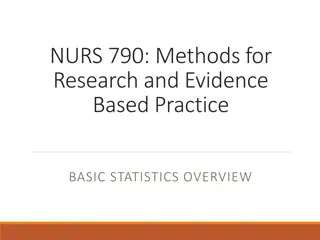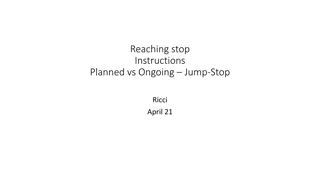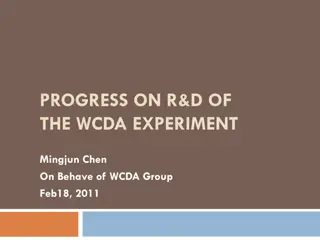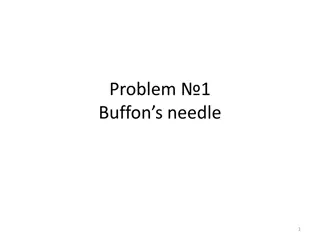Effective Strategies for Experiment Design in Statistics
In experimental design, it is crucial to accurately define variables, levels of data, and experiment type, while using appropriate controls and understanding data distribution. Reducing noise in results involves increasing the signal-to-noise ratio through techniques like repeated measurements, increasing sample size, randomization of samples, experiments, and replication. Quantitative variables benefit from techniques like making repeated measurements to improve accuracy and increasing the sample size to draw conclusions about the entire population.
Download Presentation

Please find below an Image/Link to download the presentation.
The content on the website is provided AS IS for your information and personal use only. It may not be sold, licensed, or shared on other websites without obtaining consent from the author.If you encounter any issues during the download, it is possible that the publisher has removed the file from their server.
You are allowed to download the files provided on this website for personal or commercial use, subject to the condition that they are used lawfully. All files are the property of their respective owners.
The content on the website is provided AS IS for your information and personal use only. It may not be sold, licensed, or shared on other websites without obtaining consent from the author.
E N D
Presentation Transcript
EXPERIMENT DESIGN
Experimental Design Keys to designing project with statistics in mind: Accurately and clearly define VARIABLES Accurately define LEVELS OF DATA Identify the TYPE OF EXPERIMENT (i.e. independent 2- sample, paired 2-sample, 1-sample) Making sure to use appropriate CONTROLS Making sure to understand the likely DISTRIBUTION OF DATA REDUCE EXPERIMENT NOISE (reduce random error introduced by experiment design)
Reducing Noise in Results Experimental Observations = combination Signal true effects of variable/outcome Noise random error introduced by experimental design Increase signal-to-noise ratio (decrease noise) REPEATED MEASUREMENTS (repetition / more trials) INCREASING THE SAMPLE SIZE (testing more items or individuals to better represent the whole population) RANDOMIZATION OF SAMPLES (use a lottery to assign samples to be tested to different experimental and control groups) RANDOMIZATION OF EXPERIMENTS (use a lottery to assign the order of testing different experimental groups) REPEATING EXPERIMENTS (replication of an experiment)
Quantitative Variables Technique for increasing the signal-to- noise ratio Making repeated measurements What is it? When is it helpful? Examples of when to use it Measuring a single item or event more than once to eliminate error in measuring. Especially helpful if an individual measurement may have a lot of variability; because it has to be made quickly, it is hard to determine the exact endpoint, or is technically difficult and thus prone to errors. How many drops of acid does it take to change the color of this indicator solution? Run the reaction several times on aliquots of the same solution. How long does it take for this specific graphics card to heat the air surrounding it to 100 C? Test the same exact graphics card multiple times. How long does this turtle spend underwater before surfacing for a breath? Observe the same turtle multiple times. More measurements of a single event lead to greater confidence in calculating an accurate average measurement. Does not add value if the measurement is clear-cut, like the answer to a survey question about a person's age or measuring the dimensions of a room in meters.
Quantitative Variables Technique for increasing the signal-to- noise ratio Increasing the sample size What is it? When is it helpful? Examples of when to use it Increasing the number of items, or people, that you are collecting data from increases the probability that what you are observing is indicative of the whole population. Especially helpful when you are trying to draw conclusions about an entire population. Do teenagers eat healthy foods? Survey a large number of teens, not just five people who always hang out together, about their daily diets. How do the lung capacities of smokers versus non-smokers compare? Take measurements from many smokers and non- smokers. How long does a 9-volt (V) battery from brand X power a flashlight? Test multiple manufacturing batches of brand X's 9-V battery. Does not apply if your conclusions are intended to be specific to an individual or single item. Calculations can be made to determine how large the sample size needs to be. See the guide on determining the best sample size for a survey for more details.
Quantitative Variables What is it? Technique for increasing the signal-to-noise ratio Randomization of samples When is it helpful? Examples of when to use it Which fertilization technique increases crop yield the most? Assign fertilizer treatment to each plot of land by lottery, thus evening out effects of other variables, like soil makeup and water content, among the experimental groups. Does this medication decrease osteoporosis? Randomly assign people to determining whether a medication is effective. Randomly assign patients to placebo or medication group. Using a lottery system to assign samples to different experimental and control groups within a given experiment helps make the starting makeup of the groups as equal as possible, even for variables you might have overlooked. Especially critical when the population you are drawing your samples from (which is the population you want to make conclusions about) is very heterogeneous. May not apply if you need to stratify your population because you want to be able to draw different conclusions about each sub-group. For example, men vs. women in a drug study or different types of resistors in a circuit design. Some experiments can be completely randomized; other involve blocking first. Blocking allows for the creation of homogenous groups, like males versus females, and then randomization within the block.
Quantitative Variables What is it? Technique for increasing the signal-to- noise ratio Randomization of experiments When is it helpful? Examples of when to use it Using a lottery system to determine the order of carrying out related experiments, rather than relying on an apparently logical order that may introduce other overlooked variables. Especially critical when you have related experiments from which you are going to draw a single meta conclusion. Does the length of time plastic is pressed in a mold affect the final strength of the plastic? Rather than running experiments testing 10, 20, 30, etc. seconds of pressing back to back, randomize which length of time is tested first, second, etc. The randomization eliminates potential effects from other variables like different amounts of mixing time for the plastic as the experiments progress and changes to the temperature of the mold over the course of all the experiments. Applies to both related experiments done serially using the same equipment, and related experiments done in parallel on different equipment.
Quantitative Variables What is it? Technique for increasing the signal-to- noise ratio Repeating experiments Repeating an When is it helpful? Examples of when to use it Repeating experiments is standard scientific practice for most fields. The exceptions are usually when the scale and cost of the experiments make it impossible. For example, drug trials on a rare medical condition, large-scale sociology experiments, and astronomy observations of rare phenomena. Which wavelength of visible light emits the most heat? Make repeated measurements for each wavelength, randomize the order you conduct the wavelength experiments in, and repeat the entire set of experiments at least twice more on a different days using, if possible, different equipment. experiment more than once helps determine if the data was a fluke, or represents the normal case. It helps guard against jumping to conclusions without enough evidence. The number of repeats depends on many factors, including the spread of the data and the availability of resources. Three repeats is usually a good starting place for evaluating the spread of the data.























